The GeForce GTX 1060 Founders Edition & ASUS Strix GTX 1060 Review
by Ryan Smith on August 5, 2016 2:00 PM ESTOverclocking
For our final evaluation of our GTX 1060 cards, let’s take a look at overclocking.
We’ll start things off with NVIDIA’s GeForce GTX 1060 Founders Edition. This card has a 3+1 power delivery system and a 116% TDP limit. Like the earlier GTX 1080 and 1070 cards, the GTX 1060FE can be “overvolted” to 1.093v to unlock an additional boost bin.
| GeForce GTX 1060FE Overclocking | ||||
| Stock | Overclocked | |||
| Core Clock | 1506MHz | 1706MHz | ||
| Boost Clock | 1709MHz | 1909MHz | ||
| Max Boost Clock | 1911MHz | 2100MHz | ||
| Memory Clock | 8Gbps | 9Gbps | ||
| Max Voltage | 1.062v | 1.093v | ||
We were able to overclock the GTX 1060FE’s GPU an additional 200MHz (12%), bringing the boost clock to 1909MHz. Unsurprisingly, this is very similar to the GTX 1080 and 1070, both of which overclocked by around 200MHz as well. Consequently it looks like both GP104 and GP106 seem to have similar voltage/frequency curves. Meanwhile we were able to push the memory another 1Gbps (13%) to 9Gbps.
Our other GTX 1060 is ASUS’s ROG Strix GTX 1060 OC. This card features a more advanced cooler and 6+1 power delivery system, but it also ships with a factory overclock. So all things held equal it’s likely that there’s not as much headroom for additional end-user overclocking. Meanwhile the card also ships with a built-in OC setting via ASUS’s GPU Tweak II software, which offers a small, virtually guaranteed overclock.
| ASUS Strix GTX 1060 OC Overclocking | |||||
| Stock | OC Mode | Overclocked | |||
| Core Clock | 1620MHz | 1646MHz | 1720MHz | ||
| Boost Clock | 1848MHz | 1874MHz | 1948MHz | ||
| Max Boost Clock | 2025MHz | 2050MHz | 2113MHz | ||
| Memory Clock | 8.2Gbps | 8.2Gbps | 9.2Gbps | ||
| Max Voltage | 1.062v | 1.062v | 1.093v | ||
As expected, due to its factory overclock the ASUS GTX 1060 doesn’t offer quite as much end-user overclocking. We were able to add another 100MHz (5%) to the GPU, half that of the stock clocked GTX 1060FE. Though it should be noted that in absolute terms the ASUS card has overclocked a bit farther than NVIDIA’s card, with a base clock 14MHz higher and a boost clock 39MHz higher. Meanwhile we got a slightly higher memory overclock out of the card as well, with the card topping out at 9.2Gbps, 1Gbps (12%) over the card’s shipping memory frequency.

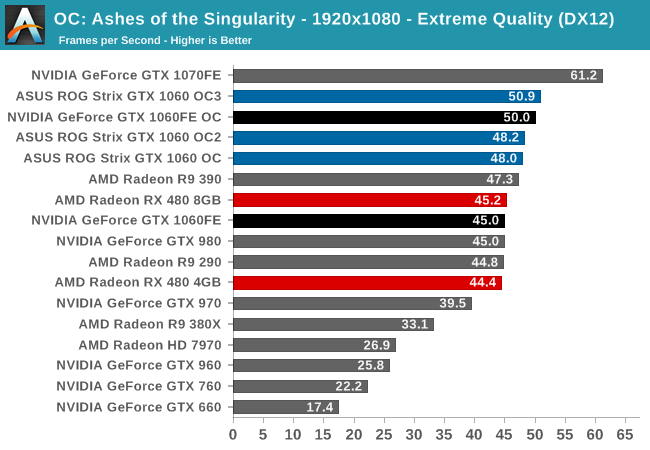
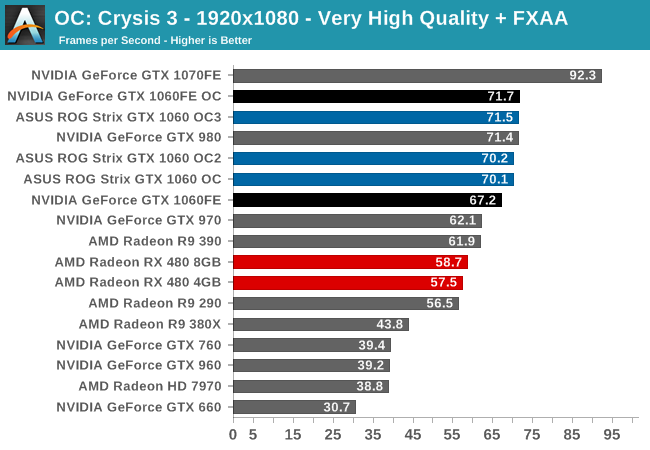

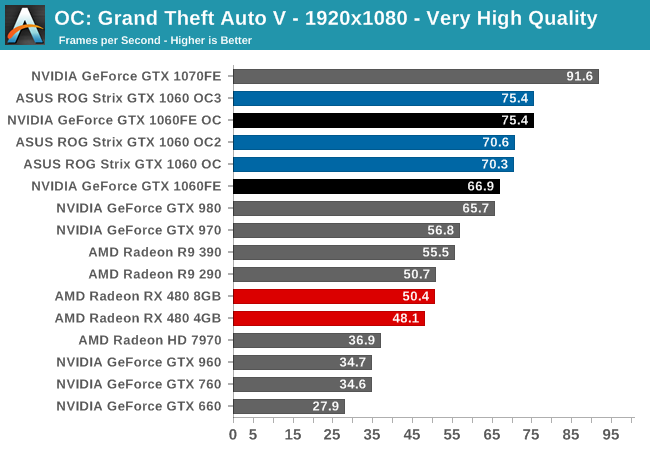
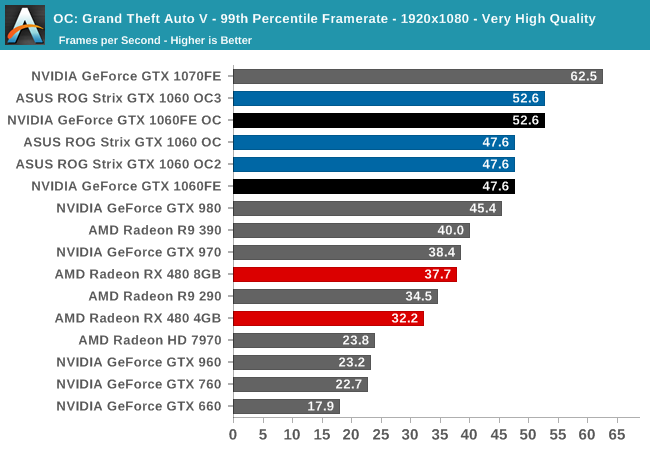
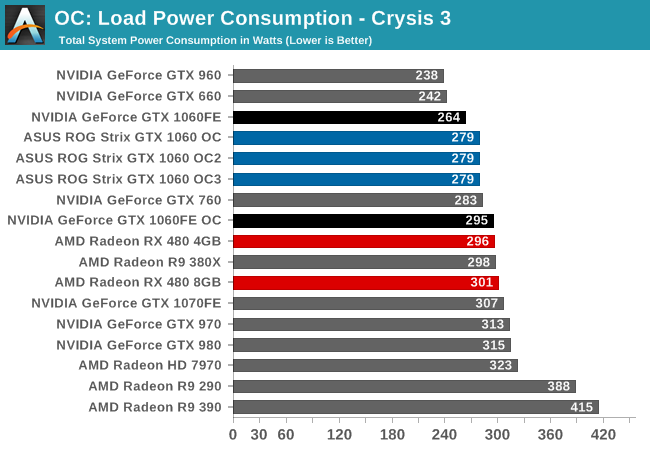
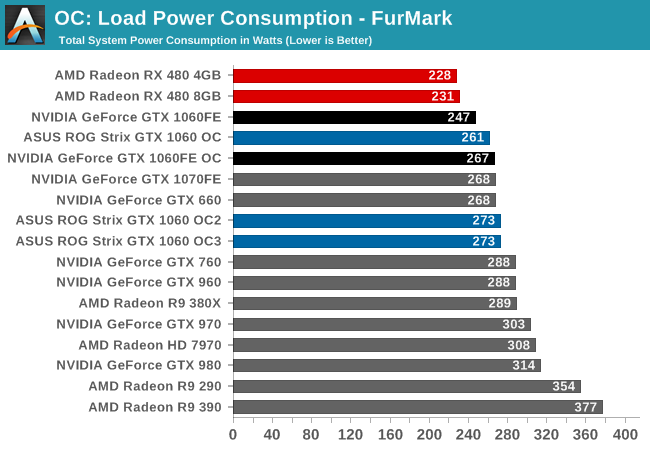
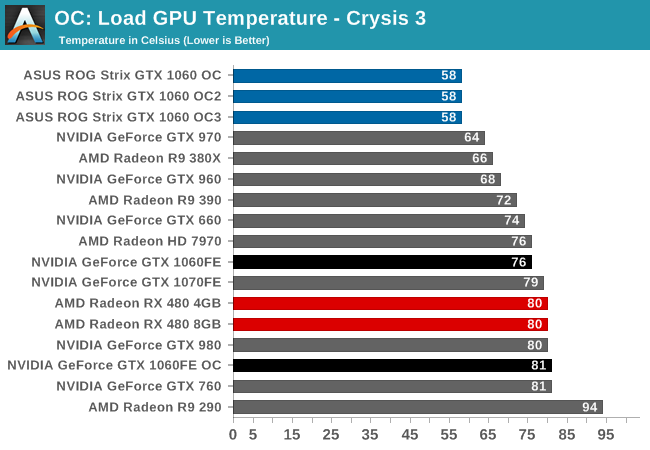
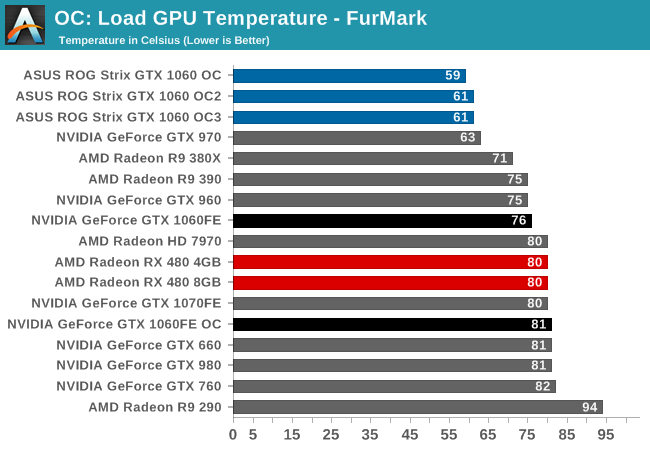
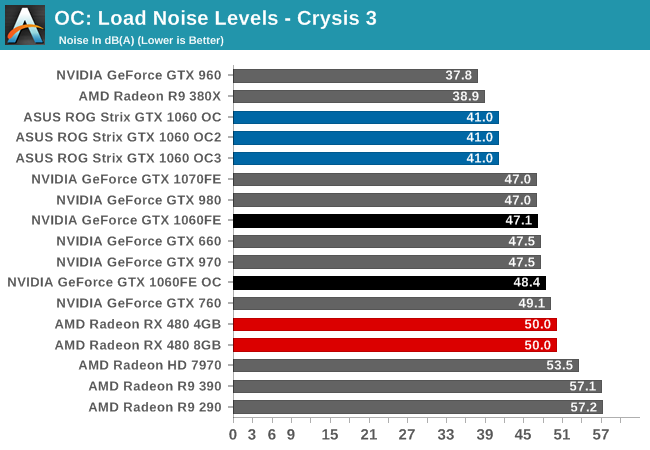
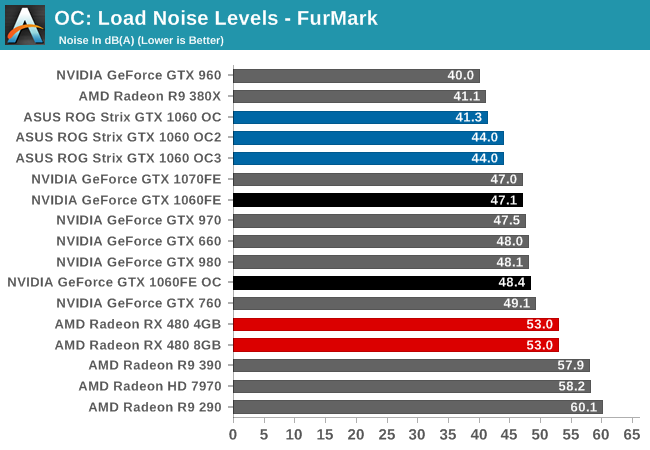
The overall performance gains and resulting power/temperate/noise costs are about as expected. The additional overclock helps the performance of the GTX 1060, but it’s nowhere near enough to close the gap with the GTX 1070. Meanwhile the final overclocks of the NVIDIA and ASUS cards are close enough that their peak performance is neck-and-neck.










189 Comments
View All Comments
Leozn01 - Wednesday, August 10, 2016 - link
Why do you guys no longer include Sony Vegas Pro in your GPU reviews?Tech-Curious - Wednesday, August 10, 2016 - link
I've been watching the RX 480 and GTX 1060 on Newegg since about two days after the former's launch. In that time, I have seen the reference 8gb 480 flash in and out of stock 2-3 times.The only 480 that was consistently available was priced waaay over the MSRP (@ $300+, the one I can find right now is at $400). 4GB models, as far as I can tell, have been nonexistent. Most importantly for me, there has been no hint of an AiB-partner board available at a decent price.
By contrast, I've seen 1060s flash in and out of stock several times in the comparatively shorter period since the 1060 launch, many of them in the $250-260 range.
The kicker was when the 470 launched and all of a sudden there were a small army of overpriced third-party 470s occupying the market segment that 480's MSRP was supposed to cover.
So, reluctantly, I snapped up a $250 1060 to replace my aging 7850. I really wanted to buy an AMD card; I had been waiting for Polaris to launch for months -- but when you combine the 480's higher power consumption, its bad reference cooler, the initial PCI-power-delivery controversy, and the lack of stock/options for what has to be at least a month now, this is what happens.
Ryan's correct; neither company's exactly in a great spot with stock, but from a cheap seats it sure seems that nVidia executed better than AMD in the short term. Pity.
m16 - Sunday, August 14, 2016 - link
I personally love blower cards. They're the best for SLI in smaller cases, but here the only good thing about them is being able to put them in small cases to begin with because there's no SLI connector.Bummer, but I bet the cards are still flying off the shelves.
Gastec - Tuesday, August 16, 2016 - link
Are you joking me? A 215% increrase in performance over GTX 960 (in Rise of the Planet of the Tomb Raider Apes) !!! Something is fishy, I can't see the performance difference in the specs. A 50-55% increase OK,but more...smelly fishy fish.Dorothycar - Sunday, September 13, 2020 - link
https://failarmy.irvision.info/anvbdnx4kq-HZKg/the...">[img]https://i.ytimg.com/vi/9JuDGFaKR-E/hqdefault.jpg[/img]The https://failarmy.irvision.info/anvbdnx4kq-HZKg/the...">Top 100 Fails of the Year (2019)FailArmy
Tonyawrize - Wednesday, October 28, 2020 - link
https://azadsoz.rulosk.info/d-m-nin-n/loJ6pKqykpq3...">[img]https://i.ytimg.com/vi/4IGryQ0bTmg/hqdefault.jpg[/img]DГјЕџmЙ™nin Г¶n xЙ™tti yarД±ldД±. DayandД±rД±lmasa, https://azadsoz.rulosk.info/d-m-nin-n/loJ6pKqykpq3...">QarabaДџ tam azad olunacaq
YasminHef - Saturday, October 31, 2020 - link
https://movstudio.thmatch.info/2KhzaqO2rslodZk/s-r...">[img]https://i.ytimg.com/vi/uwB1BUyg8Dg/hqdefault.jpg[/img]สรุปเนื้аёаё«аёІ Speed เร็วกว่านรก - MOV https://movstudio.thmatch.info/2KhzaqO2rslodZk/s-r...">Studio
Estherbouts - Sunday, November 1, 2020 - link
https://wrestlechatter.mrcameras.info/roman-reigns...">[img]https://i.ytimg.com/vi/wpo4PEO6oj4/hqdefault.jpg[/img]Roman Reigns Winning Universal Title CONFIRMED, Jon Moxley #1 https://wrestlechatter.mrcameras.info/roman-reigns...">Superstar, Payback Match Card, Top 500
Marshalef - Monday, November 2, 2020 - link
https://apodrash.grgone.info/q99inqKpacVus2Q/me-k-...">[img]https://i.ytimg.com/vi/Gy0frp9a6R0/hqdefault.jpg[/img]ОњОµ ОєО¬О»ОµПѓО±ОЅ ПѓП„Ої Alpha https://apodrash.grgone.info/q99inqKpacVus2Q/me-k-...">(Happy Day 7:45 ПЂ.Ој)